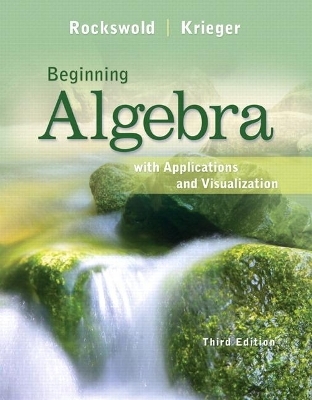
Beginning Algebra with Applications and Visualization Plus NEW MyLab Math with Pearson eText -- Access Card Package
Pearson (Verlag)
978-0-321-72940-8 (ISBN)
Packages
Access codes for Pearson's MyLab & Mastering products may not be included when purchasing or renting from companies other than Pearson; check with the seller before completing your purchase.
Used or rental books
If you rent or purchase a used book with an access code, the access code may have been redeemed previously and you may have to purchase a new access code.
Access codes
Access codes that are purchased from sellers other than Pearson carry a higher risk of being either the wrong ISBN or a previously redeemed code. Check with the seller prior to purchase.
-- The Rockswold/Krieger algebra series fosters conceptual understanding by using relevant applications and visualization to show students why math matters. It answers the common question “When will I ever use this?” Rockswold teaches students the math in context, rather than including the applications at the end of the presentation. By seamlessly integrating meaningful applications that include real data and supporting visuals (graphs, tables, charts, colors, and diagrams), students are able to see how math impacts their lives as they learn the concepts. The authors believe this approach deepens conceptual understanding and better prepares students for future math courses and life.
Gary Rockswold has been a professor and teacher of mathematics, computer science, astronomy, and physical science for over 35 years. He has taught not only at the undergraduate and graduate college levels, but he has also taught middle school, high school, vocational school, and adult education. He received his BA degree with majors in mathematics and physics from St. Olaf College and his Ph.D. in applied mathematics from Iowa State University. He has been a principal investigator at the Minnesota Supercomputer Institute, publishing research articles in numerical analysis and parallel processing and is currently an emeritus professor of mathematics at Minnesota State University, Mankato. He is an author for Pearson Education and has over 10 current textbooks at the developmental and precalculus levels. His developmental coauthor and friend is Terry Krieger. They have been working together for over a decade. Making mathematics meaningful for students and professing the power of mathematics are special passions for Gary. In his spare time he enjoys sailing, doing yoga, and spending time with his family. Additional information about Gary Rockswold can be found at www.garyrockswold.net. Terry Krieger has taught mathematics for 18 years at the middle school, high school, vocational, community college and university levels. His undergraduate degree in secondary education is from Bemidji State University in Minnesota, where he graduated summa cum laude. He received his MA in mathematics from Minnesota State University - Mankato. In addition to his teaching experience in the United States, Terry has taught mathematics in Tasmania, Australia, and in a rural school in Swaziland, Africa, where he served as a Peace Corps volunteer. Terry is currently teaching at Rochester Community and Technical College in Rochester, Minnesota. He has been involved with various aspects of mathematics textbook publication for more than 14 years and has joined his friend Gary Rockswold as coauthor of a developmental math series published by Pearson Education. In his free time, Terry enjoys spending time with his wife and two boys, physical fitness, wilderness camping, and trout fishing.
1. Introduction to Algebra
1.1 Numbers, Variables, and Expressions
1.2 Fractions
1.3 Exponents and Order of Operations
1.4 Real Numbers and the Number Line
1.5 Addition and Subtraction of Real Numbers
1.6 Multiplication and Division of Real Numbers
1.7 Properties of Real Numbers
1.8 Simplifying and Writing Algebraic Expressions
2. Linear Equations and Inequalities
2.1 Introduction to Equations
2.2 Linear Equations
2.3 Introduction to Problem Solving
2.4 Formulas
2.5 Linear Inequalities
3. Graphing Equations
3.1 Introduction to Graphing
3.2 Linear Equations in Two Variables
3.3 More Graphing of Lines
3.4 Slope and Rates of Change
3.5 Slope-Intercept Form
3.6 Point-Slope Form
3.7 Introduction to Modeling
4. Systems of Linear Equations In Two Variables
4.1 Solving Systems of Linear Equations Graphically and Numerically
4.2 Solving Systems of Linear Equations by Substitution
4.3 Solving Systems of Linear Equations by Elimination
4.4 Systems of Linear Inequalities
5. Polynomials and Exponents
5.1 Rules for Exponents
5.2 Addition and Subtraction of Polynomials
5.3 Multiplication of Polynomials
5.4 Special Products
5.5 Integer Exponents and the Quotient Rule
5.6 Division of Polynomials
6. Factoring Polynomials and Solving Equations
6.1 Introduction to Factoring
6.2 Factoring Trinomials I (x + bx + c)
6.3 Factoring Trinomials II (ax2 + bx + c)
6.4 Special Types of Factoring
6.5 Summary of Factoring
6.6 Solving Equations by Factoring I (Quadratics)
6.7 Solving Equations by Factoring II (Higher Degree)
7. Rational Expressions
7.1 Introduction to Rational Expressions
7.2 Multiplication and Division of Rational Expressions
7.3 Addition and Subtraction with Like Denominators
7.4 Addition and Subtraction with Unlike Denominators
7.5 Complex Fractions
7.6 Rational Equations and Formulas
7.7 Proportions and Variation
8. Radical Expressions
8.1 Introduction to Radical Expressions
8.2 Multiplication and Division of Radical Expressions
8.3 Addition and Subtraction of Radical Expressions
8.4 Simplifying Radical Expressions
8.5 Equations Involving Radical Expressions
8.6 Higher Roots and Rational Exponents
9. Quadratic Equations
9.1 Parabolas
9.2 Introduction to Quadratic Equations
9.3 Solving by Completing the Square
9.4 The Quadratic Formula
9.5 Complex Solutions
9.6 Introduction to Functions
Appendix A: Using the Graphing Calculator
Appendix B: Sets
Answers to Selected Exercises
Glossary
Bibliography
Photo Credits
Index
| Erscheint lt. Verlag | 1.3.2012 |
|---|---|
| Sprache | englisch |
| Maße | 10 x 10 mm |
| Gewicht | 1588 g |
| Themenwelt | Mathematik / Informatik ► Mathematik ► Algebra |
| ISBN-10 | 0-321-72940-4 / 0321729404 |
| ISBN-13 | 978-0-321-72940-8 / 9780321729408 |
| Zustand | Neuware |
| Informationen gemäß Produktsicherheitsverordnung (GPSR) | |
| Haben Sie eine Frage zum Produkt? |
aus dem Bereich


